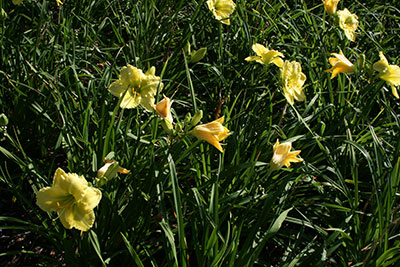Daylilies

Daylilies are among the most popular perennials grown in Florida. These hardy plants are relatively pest-free and have a long blooming period.
One reason for daylilies’ popularity is its variety. The plants are available in different growth habits, flower shapes, and colors, including yellow, orange, red, pink, purple, and creamy white. Some daylilies are evergreen, while others are deciduous. There are early-season bloomers that start flowering in March and late-season daylilies that won’t bloom until mid-May. The typical bloom period is about four to seven weeks, although some varieties bloom even longer.
Select a combination of early- and late-season bloomers to extend the flowering season. Daylilies make the biggest impact in your landscape if you group multiple plants of the same color together.
Potted daylilies establish easily, and can be found at garden centers although the choices are usually limited. For a wider range of options, look to nurseries that specialize in daylilies. They sell bare-root plants at the site, by mail-order or on-line. Local nurseries typically carry the best performers for their regions as well as the latest varieties. Daylilies tend to be reasonably priced, but some varieties can be very expensive.
Daylilies can be planted throughout the year in Florida; however, spring and fall are ideal. Plant daylilies 18 to 24 inches apart, since some varieties multiply quickly and can become crowded. Daylilies are quite drought-tolerant, but perform best when moisture is readily available. Water well, mulch and keep the soil moist until plants are well established.
Propagating Daylilies
Daylilies can multiply fairly fast, and can easily be propagated at home. To create more plants from your daylilies through plant division, dig them up immediately after they finish flowering. Make sure you get the entire clump, and shake or wash off the soil without damaging the roots.
Cut the leaves off about six inches above the crown and divide the clump with a sharp knife. Smaller clumps can just be pulled apart. Prune the old portions of the roots to promote new root development. Replant these sections as new plants.
The flower stems of daylilies often develop small plantlets. These can also be removed and rooted to form another plant. Daylilies, like many other types of garden lilies grown in Florida, contain various toxic alkaloids and can cause poisoning if consumed.
